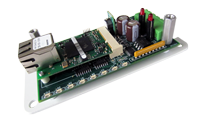|
In selecting a good pulse value, there are three general schools of thought. Of course, these may not be all-inclusive, but over the years I have found that most utilities use one of these general methods or some variation.
As you recall, the Pulse value is generally set by programming the Ke value, the secondary pulse constant, into the meter and multiplying that Ke value by the Meter Multiplier at any particular metering installation. The Multiplier is the CT ratio, or CT X PT ratio in larger applications. In self-contained metering applications, the multiplier is 1. The Primary Pulse Constant or Value is referred to as PKe.
Method #1
Method #1 is giving the customer the Primary Pulse Constant PKe that they desire. For instance, let’s say a customer needs a pulse value for their EMS system of .144 kWh per pulse (Form C). Further assume that the customer has an instrument-rated meter with 400A:5A CT’s, a ratio of 80. Since this is a relatively small service, let’s assume that there are no VT’s or PT’s. Therefore, the Ke value that would be programmed into the meter would be .144kWh/80=.0018 kWh. This allows direct compatibility for the customer without having to change the Pulse Value of their EMS but does require the utility to keep a record of the pulse value without having to look and see what the meter’s Ke value is programmed for.
Method #2
Method #2 is convenient because the PKe value is set to the same number as the Meter Multiplier. In this scenario, Ke is set to .001kWh/pulse (1Wh/pulse). For example, in the above scenario, .001 kWh * 80 = .080 kWh per pulse (Form C) (80 Watthours per Pulse). This is generally a very good system for several reasons. First, this is good resolution, and a pulse rate that most EMS system would have no trouble handling. Second, the utility does not have to remember what the Ke value is for any customer installation since all meters are programmed with a Ke value of .001. Third, since CT ratios and thus Multipliers increase as customers’ service sizes go up, the pulse values become larger as service sizes become larger, and thus there would rarely be an instance of pulses being too fast or or too small a value.
Method #3
Method #3 is the “Rule of 3.6”. The Rule of 3.6 allows you to calculate the customer’s PKe value, and thus Ke value, such that the resulting pulse rate would be one pulse per second at full scale kW demand. This offers excellent resolution without any danger of exceeding the maximum register value or pulse input capacity of the pulse receiving equipment. Please refer to the link below for a complete description of the Rule of 3.6.
Rule of 3.6 Article
Contact Solid State Instruments for any help with Pulse Metering applications.
Author: Bill Brayden |

PMC-1 Pulse Modbus Converter
|

